-
You are here:
Home
›
-
History of South Africa
›
-
The Mfecane / Difaqane war
Rise of the Zulu people under King Shaka Zulu
during the "Mfecane / Difaqane" war
The rise of the Zulu people under their King
Shaka Zulu during the "Mfecane / Difaqane" war was one of the most significant historical occurrences in
the early history of South Africa.
The term Mfecane (Nguni languages) means "destroyed in total war".
The Sotho speaking people on the highveld used the term Difaqane, which means "hammering" or
"forced migration/removal".
The "Mfecane / Difaqane" war forever changed the settlement patterns and ethnic structure of the
African population of the area.
Whole communities of peoples were displaced in their flight from larger warring tribes. The
winning tribes would often incorporate the losers into their tribes.
Three key figures in this all out battle for power among the African tribes in Southern Africa
were Dingiswayo (leader of the Mtethwa tribe), Zwide (leader ofthe Ndandwe tribe) and of course
King Shaka.
Learn more about the rise of this mighty nation of warriors in South
Africa, using the menu below;
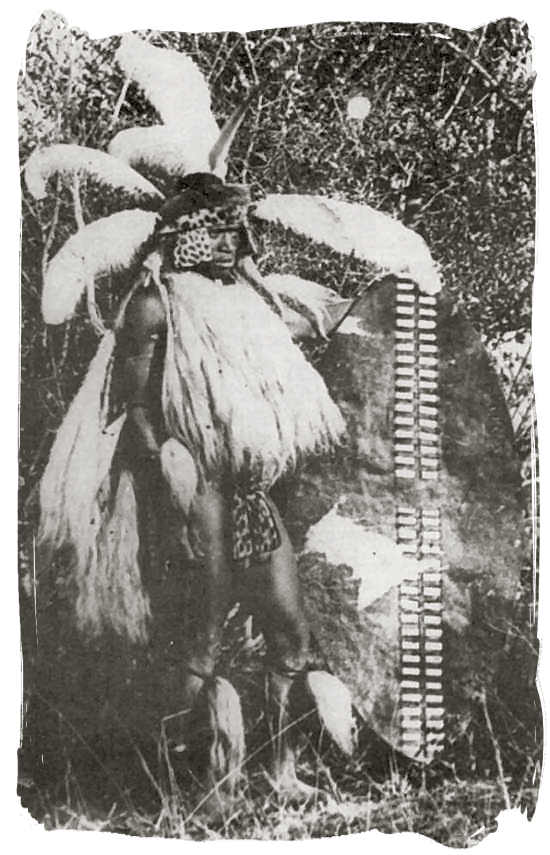
19th century photograph of a warrior
The Mfecane / Difaqane war
The Mfecane had a great influence on the history of South Africa. Large parts of the country in Natal, the
Transvaal and Free State were largely depopulated because people fled in droves to safer areas such as the
Transkei, the edge of the Kalahari, the Soutpansberg and the present day Lesotho. In consequence, these
areas could not cope with the sudden influx and became overpopulated.
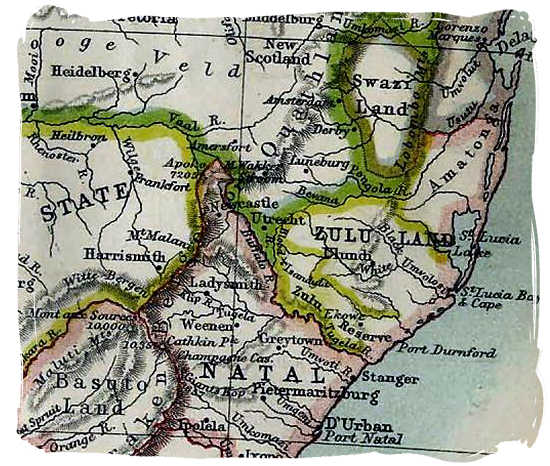
Enlargement of a section of a 1885 map of South Africa showing geographical details of Zululand and Natal
Rise of the Zulu people under King Shaka Zulu
After the Mfecane, the Black peoples were living in an area shaped like a horseshoe. The Tswana and Pedi
lived in the west and the Venda, Shangaan, Tsonga and Swazi lived in the north. The Zulu people lived in the
eastern part of the country, as did the Sotho and the inhabitants of both Transkei and Ciskei. The whites
took advantage of this situation by moving into the empty areas and in this way the ethnic map of South
Africa was changed completely.
Many people died during the Mfecane. Violence and starvation were rampant, because the livestock was stolen
and people could not stay long enough in one place to cultivate crops. Although hundreds of thousands of
people lost their lives, it also gave rise to the formation of big new nations such as the Sotho. The
tribes of leaders such as Dingane, Shaka, Mzilikazi and Soshangane were significantly strengthened and
changed.
<< Top of Page
Dingiswayo chief of the Mthethwa
When Dingiswayo became leader of the Mthethwa, his main concern was to improve the military system of his
tribe. Young men of a similar age were divided into regiments. Each regiment had its own name, colour and
weapons. The young men were even required to remain celibate until such time when they had proven
themselves worthy of the name “warrior”.
Dingiswayo’s army soon went from strength to strength and was employed in an attempt to expand his territory.
The army attacked smaller tribes which were allowed to continue their existence as tribes, but only if they
agreed to recognise him as their paramount chief. Some of the tribes which were dominated in this way were the
Thembu, Qwabe, Mshali Mngadi and the Zulus.
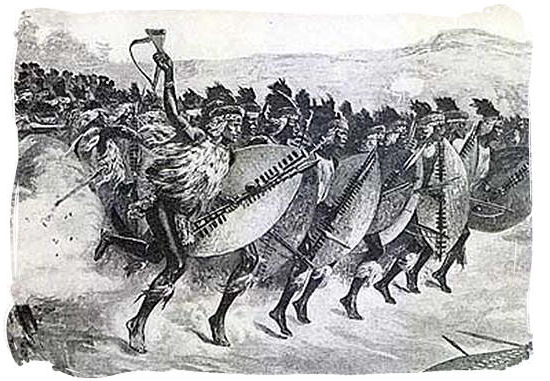
Zulu army on the attack
<< Top of Page
Shaka, king of the Zulus
The Zulus were initially a small tribe which recognised Dingiswayo as its paramount chief. The tribe
consisted of approximately 2 000 people and its tribal chief was Senzangakona. Shaka, his son, was born in
around the year 1787. Shaka and his mother Nandi could not get along with some of the other members of the
family and went to live with Nandi’s family, among the Lungeni people.
When Shaka was 16, his mother took him to the Mthethwa and, at the age of 22, he became a soldier in one of
Dingiswayo's regiments. He was brave and intelligent and soon became leader of one of the regiments. When
Senzangakona died in 1816, Sigujane, a half-brother of Shaka, became chief. Shaka, together
with another half-brother Ngwadi, plotted against Sigujane, who was soon murdered.
With a regiment borrowed from Dingiswayo, Shaka made himself chief of the Zulus. Shaka was an exceptional
military leader and organised his armies with military precision. All the men younger than forty were
divided into regiments, based on their age. Shaka built his capital at Bulawayo and, although he recognised
Dingiswayo as paramount chief, started incorporating smaller tribes into the Zulu nation.
In 1819, when war broke out between the Ndwandwe and Mthethwa, Dingiswayo was killed by Zwide, after which
the defeated Mthethwa tribe was incorporated into Shaka’s tribe. In time, Shaka destroyed the Ndwandwe tribe
completely.
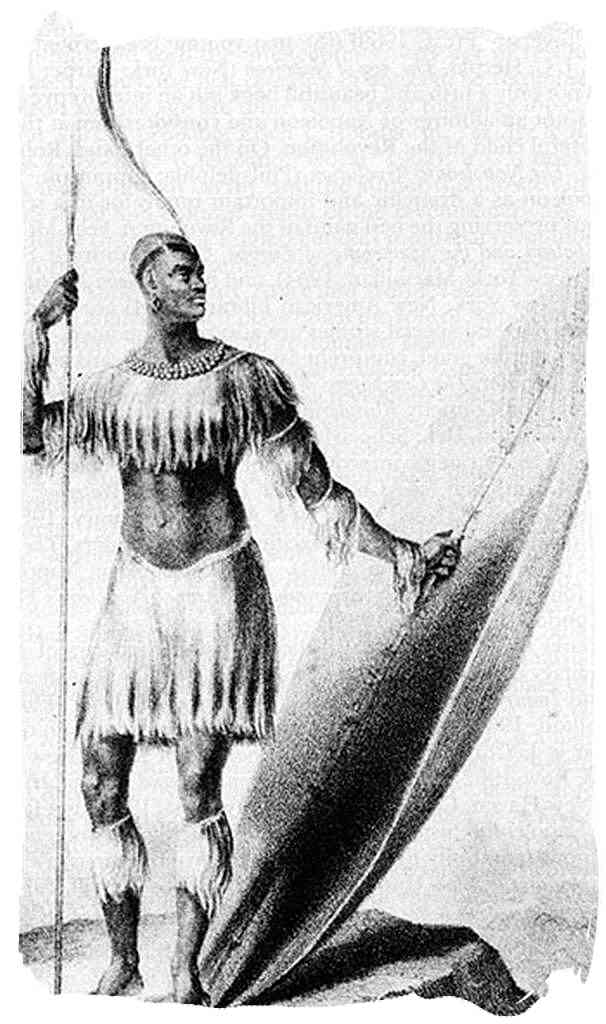
Only known drawing of King Shaka standing with the long throwing assegai and the heavy shield in 1824 - four years before his death
Rise of the Zulu people under King Shaka Zulu
He employed cunning military techniques such as the following: when Zwide sent the Ndwandwe to attack
Shaka, the latter hid the food and led his people and cattle further and further away from the capital.
Zwide’s army followed and Shaka’s soldiers waited until night fell to attack them, when they were exhausted
and hungry.
The Ndwandwe army turned back, after which Shaka attacked and destroyed them. A second attempt was made by
Zwide later in 1819 to destroy Shaka, but once again the Ndwandwe had no luck. After this attempt, Shaka
ordered the complete destruction of the Ndwandwe people.
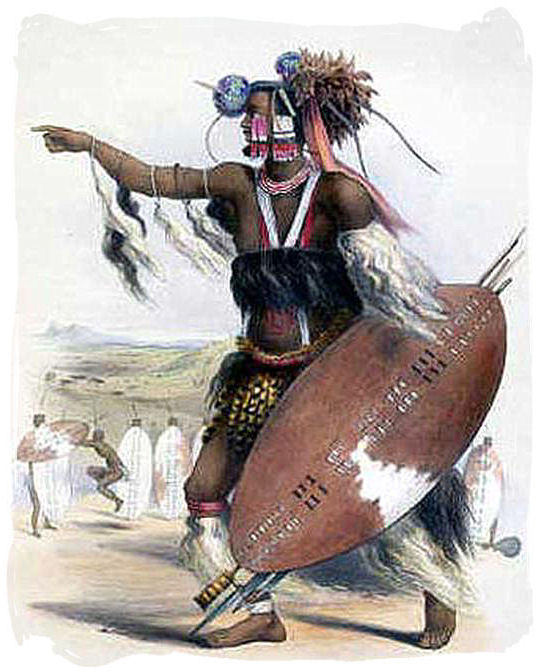
Warrior Utimuni, nephew of King Shaka, commander of one of Shaka's regiments
Shaka went on destroying several smaller tribes until Natal was practically depopulated. The Zulus
eventually grew into a mighty nation when Shaka succeeded in uniting all the people in his chiefdom under his
rule. In 1828, two of Shaka's half-brothers, Dingane and Mahlangane, murdered him and Dingane took
his place as leader.
<< Top of Page
Dingane, Shaka's successor
Dingane’s capital was built at Umgungundlovu. He was not as good a soldier as Shaka and this caused his
defeat in many of his wars. In order to combat the decline of his kingdom, Dingane decided to kill a
few important leaders.
One of these leaders, Ngeto (of the Qwabe tribe), realised that his life was in danger and, after gathering
his people and livestock, fled southwards and settled in the Mpondo district, from which he himself
started to attack other tribes. Dingane soon sent soldiers to fight the Mpondo people but he also launched
attacks against Mzilikazi and the Voortrekkers.
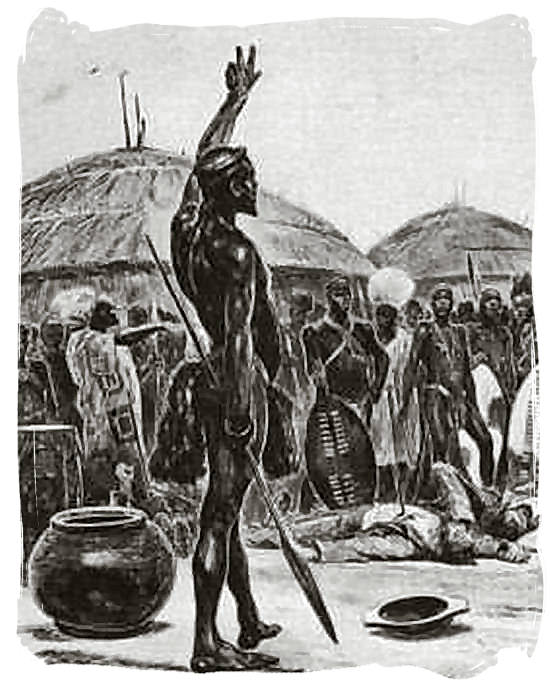
Sketch of King Dingane at the murder of PietRetief and his men.
Rise of the Zulu people under King Shaka Zulu
On 3 February 1838, Dingane's tribesmen killed Piet Retief, together with 67 of his followers, during an
ambush. Retief had an agreement with Dingane that if he succeeded in returning Dingane's cattle that
had been stolen by Sikonyela, the Voortrekkers would be allowed to buy land from him and his people.
When the Voortrekkers returned with the stolen cattle, they were killed. The Voortrekkers swore vengeance
and Dingane's army was defeated at Blood River on 16 December 1838 by Andries Pretorius. Dingane’s death
brought with it an end to the extermination wars waged by him and his armies. However, in other parts of the
country, the Mfecane continued under leaders such as Msilikazi, Soshangane and Sikonyela.
<< Top of Page
Mzilikazi king of the Matabele
Another small Nguni tribe that was forced to join Zwide’s Ndwandwe tribe was called the Khumalo. The Khumalo
tribe was suspected of treachery during the war against Dingiswayo’s Mthethwa and its leader, Mashobane,
was summoned to Zwide’s kraal and killed. Zwide appointed Mzilikazi as the new leader of the Khumalo.
He was an intelligent leader who knew how to gain the trust of the tribes that had been incorporated into
his own. Trouble started when Mzilikazi began to suspect that Zwide wanted to kill him. In preparation,
Mzilikazi formed an alliance with Shaka, who allowed him to be the leader of one of his regiments.
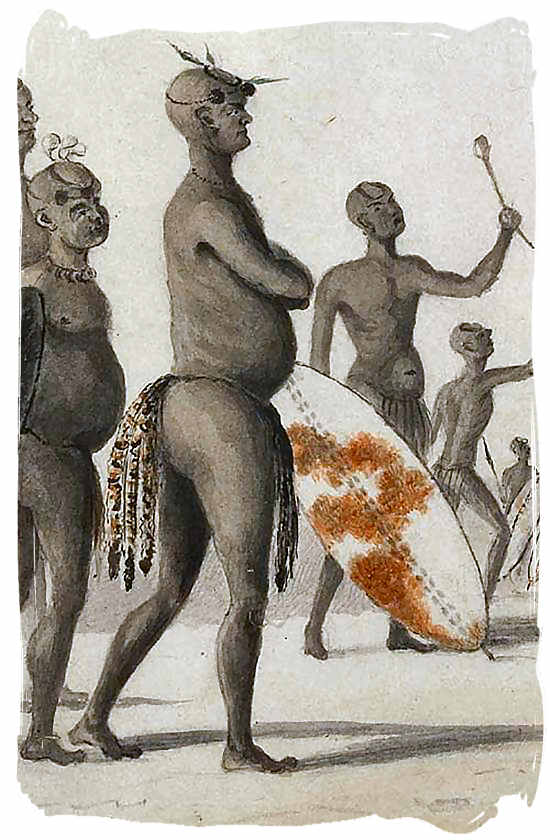
Watercolour sketch of Mzilikazi, chief of the Khumalo tribe and later king of the Matabele
In 1821, Mzilikazi felt strong enough to become independent. Shaka sent him to attack a small Sotho tribe
northwest of Zululand and, as always, he brought back with him a number of cattle taken during the battle.
However, this time he did not hand them over to Shaka as he had done before. When Shaka sent his
messengers to collect the cattle, Mzilikazi refused to return them. After this, he was attacked by Shaka's
army and had no option but to flee with his people.
Mzilikazi trekked northwards with his people until he reached the Olifants (Elephants) River. He was now in
the territory of powerful Sotho tribes, which he attacked, taking their women, children and livestock. He
attacked tribes as far as Tswanaland and overpowered them by the military tactics perfected by the Zulus. His
tribe eventually became known as the Matabele.
Mzilikazi decided to trek to the central Transvaal and he eventually settled in the vicinity of what is
today known as Pretoria. He moved because he needed to put even more distance between himself and Shaka
and he was also in need of more grazing land. After this move, his tribe became even more bloodthirsty.
When the Voortrekkers came on the scene in 1836, Mzilikazi once again went on the attack. At Vegkop, the
Voortrekkers succeeded in defeating the Matebele, but they lost all their cattle. In 1837, the Voortrekkers
once again succeeded in defeating the Matebele at Mosega and the Voortrekkers, under the leadership of
Potgieter, recovered some of their stolen cattle.
The Matabele then moved away only to be defeated by the Zulus. In an attempt to get away from his enemies,
Mzilikazi crossed the Soutpansberg Mountains and the Limpopo River into which is today known as Zimbabwe in
1868. He died there a some years later.
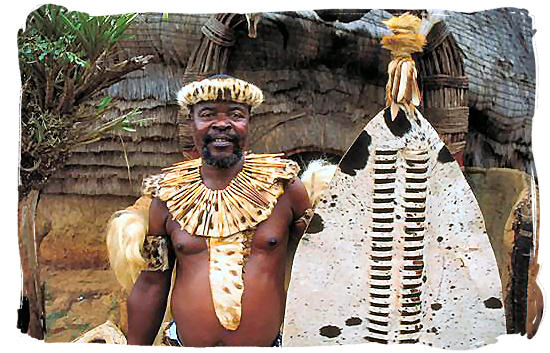
Induna in full regalia, name for a chief or a commander of a group of Zulu warriors appointed by the king
Rise of the Zulu people under King Shaka Zulu
<< Top of Page
Chief Soshangane
After the tribes of Zwide, Soshangane, Zwangendaba and Nxaba,had been defeated by Shaka, they fled to
Mozambique. There, they destroyed the Portuguese settlement at Delagoa Bay.
As the Mfecane continued, the land was devastated and tribes were attacked. Much damage was done.
Soshangane's capital was near the modern day Maputo and Shaka attacked him here in the campaign that cost
Shaka’s life. Soshangane then moved on to Middle Sabie and settled near Zwangendaba and his people.
The tribes of Soshangane and Zwangendaba coexisted in harmony until 1831, when they went to war.
Zwangendaba had to flee before Soshangane, after which Soshangane, went on to attack Nxaba, who responded
by fleeing with his followers to the present-day Tanzania.
With Soshangane’s biggest enemies out of the
way, he began building his Gaza Kingdom. From his capital, Chaimite, soldiers were sent in all directions
to attack other tribes. Even the Portuguese were forced to accept him as paramount chief.
His kingdom stretched from the Zambezi to the Limpopo Rivers and his army resembled that of the Zulus in
its military strategies. As Soshangane grew older, he began to believe that the Matshangano had bewitched
him. In retaliation, he attacked them and many fled to the Transvaal where their descendants still live
today. Soshangane died around the year 1826.
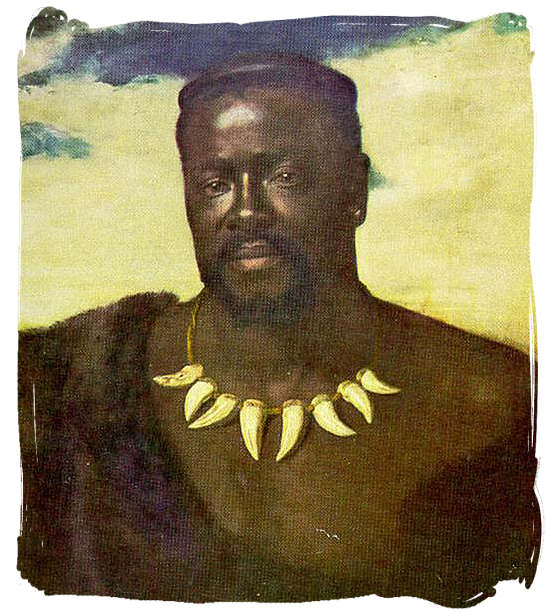
A painting of Cetshwayo kaMpande (circa 1826 - February 8, 1884) who was the king of the Zulus from 1872 to 1879 and their leader during the Anglo / Zulu War.
<< Top of Page
Sikonyela and his mother Mmantatise
During the early 19th century, two of the biggest Nguni tribes, the Hlubi and the Ngwane, lived near the
present-day Wakkerstroom. The Hlubi were under the leadership of Mpangazita and Matiwane was the leader of
the Ngwane. The Zulus had forced these two tribes across the Drakensberg Mountains into Sotho territory,
which meant the start of the Mfecane for the Sotho tribes.
The first tribe to be attacked was the Batlokwa. The tribe’s chief had just died and his successor,
Sikonyela, was still too young to rule. His mother, Mmantatise was a strong leader and ruled in his place.
After the Hlubi tribe defeated the Batlokwa, they took to wandering around and attacking other tribes and
tribes such as the Bafokeng were forced to flee. The Batlokwa eventually settled at Butha-Buthe, a
mountain stronghold.
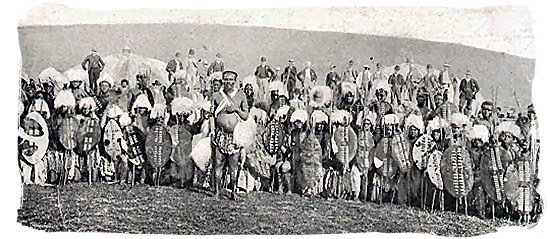
Zulus warriors on a post card from the late 1800s
Rise of the Zulu people under King Shaka Zulu
Moshweshwe was living on the mountain with his small tribe and after repeatedly attacking Mmantatise,
Moshweshwe’s tribe moved to Peka. There they continued the Mfecane and defeated the Hlubi. Sikonyela was by
now old enough to lead the Batlokwa in battle and, in 1824, they made another attempt to re-conquer
Moshweshwe’s mountain stronghold at Butha Buthe.
The mountain was surrounded in order to stop the Sotho people from obtaining food. After two months, a
Nguni tribe came to Moshweshwe’s rescue and the Batlokwa were forced to leave. The Batlokwa subsequently
went to settle on two other mountains. In 1852, Moshweshwe finally drove the Batlokwa away.
<< Top of Page
Moshweshwe builder of the Sotho empire
Moshweshwe, the builder of the Sotho empire, was born in 1793. His mother belonged to the Bafokeng tribe
and his father was chief of the Bakwena tribe. When the Mfecane began in 1816, Moshweshwe was 23 years old.
During the early years of his chieftainship, leaders such as Shaka, Dingane and Mzilikazi were waging the
destructive wars of the Mfecane.
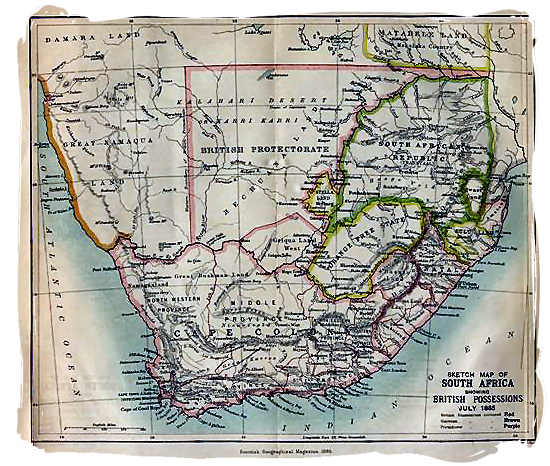
1885 map of Southern Africa showing the British possessions
Many of the people who got caught up in these wars turned to Moshweshwe for refuge. He took them all in and
his tribe grew bigger and stronger. In 1823, Moshweshwe established Butha-Buthe as the capital of his
chiefdom. A year later, he established a safer stronghold at Thaba Bosigo.
This mountain stronghold was so secure that when Mzilikazi attacked it in 1831, he had to turn back without
accomplishing anything. Moshweshwe was a diplomatic and powerful leader and was too clever to try to expand
his territory northwards because he knew that this would incur the wrath of strong leaders such as
Mzilikazi, Shaka and Dingane.
Top of Page
-
Home
›
-
History of South Africa
›
-
The Mfecane / Difaqane war

